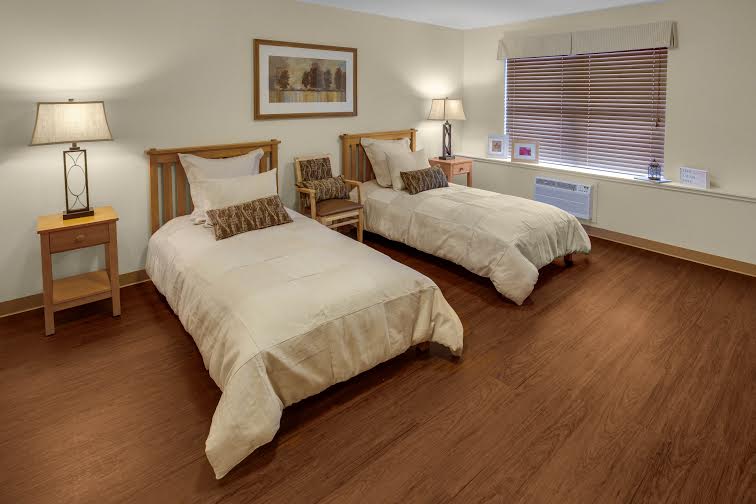Some argue that senior housing has shifted toward becoming a health care business wrapped in a real estate bow. That holds especially true when it comes to memory care, where residents have distinct care needs—but if not real estate, then what exactly is memory care selling?
At a quantitative level, memory care units tend to be smaller than those in either independent or assisted living. In part, that’s because independent living units generally resemble apartments, with one or two bedrooms, living areas and kitchens. Memory care’s direct care and service offerings, however, tend to be more robust than those in its independent and assisted living counterparts, prompting some providers to reconsider how they market themselves.
One such provider is Anthem Memory Care, a developer and operator based in Oregon that has built and manages six memory care communities in California, Colorado and Illinois, with two more soon to open.
Nice rooms and attractive buildings are important, Anthem Principal Mark Rockwell tells Senior Housing News. Rooms in Anthem’s buildings range from 250 square feet to 390 square feet, but at the end of the day, memory care isn’t a real estate transaction.
“It simply means that we step back and say, ‘What business are we in?’” he says. “Our business is a care model, not a real estate model. Why would we lead with selling real estate?”
Care-centric Pricing
Anthem has taken the approach of presenting its care model to potential residents first and foremost, because it can be confusing to talk about selling something in the form of room rates, Rockwell says. Doing so could lead families to think their loved ones are receiving less care if they choose a smaller or shared room as opposed to a larger one.
“We’re not in the business to rent rooms,” Rockwell says. “We need to talk about the kind of care [residents] are going to get. [Families] are not going to come to us because we have the best building. They should be coming to us because we have great care.”
Anthem offers two levels of care to its residents at two distinct price points, the first of which encompasses basic services such as hands-on assistance with incontinence products and stand-by assistance or verbal cueing for activities of daily living. Level two is deemed all-inclusive and includes hands-on transfer, restroom, and hygiene and mobility assistance, among other services.
Some companies bump prices up more precisely, scoring residents by points based on their level of cognitive impairment and care needs, for example, and charging families more as the points go up, Rockwell says. But again, that can lead to confusion.
“The simpler we can keep our pricing, the better off we are and the happier families will be,” he says. “Those rent components are going to be different, but the care piece is always the same.”
That’s not to say one pricing strategy is necessarily superior to the other, Rockwell says. The point is being very upfront and straightforward about how pricing will run, and emphasizing the care residents will receive.
“We try to keep our pricing in general pretty constant,” Rockwell says. “There shouldn’t be much fluctuation.”
When it comes to why families turn to memory care, it usually has little to do with elaborate amenities on offer or the size of a bedroom, says Andrèa Catizone, President of Senior Living SMART, a resource hub for smaller, independent providers. Instead, they’re looking to improve their loved ones’ quality of life.
“For families, it’s typically a very emotional and need-driven sale,” she says. “There’s a reason they pick up the phone when they do. I’ve found it’s very rarely the real estate that families will focus on.”
Even amenities deemed important in memory care have a care focus, Catizone says. Whereas a potential independent living resident might be more concerned with whether there’s an onsite swimming pool or putting green, memory care might tout its access to a safe outdoor area for fresh air, or significant community spaces for indoor activities to foster resident engagement.
Importance of Engagement
Beyond care itself, day-to-day activities prove especially crucial in selling memory care.
“You have to be willing to try anything and everything,” says Jenni Seaman, life engagement director at Chelsea Place, an Anthem community in Aurora, Colorado. “You can’t get stuck in a rut of doing the same things over and over again.”
Chelsea Place focuses on community involvement and intergenerational programming, which can range from visiting a local elementary school so that students can read to residents, to simply taking residents out to lunch and stopping at the park on the way back. The reading program has been successful, in particular, as it offers a chance for residents to give care instead of being the recipients of it. Plus, they’re treated like celebrities among the children, Seaman says.
Caregivers at Chelsea Place are involved in residents lives beyond care, as well, as they’re expected to dedicate 25% of their workload toward engaging with residents. That way, their jobs aren’t entirely task-oriented, and it allows residents the opportunity to be part of the community at large, setting tables or filling bird feeders, and again, not simply the recipients of care.
“I think that’s becoming more and more what consumers are looking for,” Seaman says. “The engagement piece is what people are really wanting to see [in memory care].”
Catizone agrees, explaining that families’ first criteria typically revolves around how close the community is from their own homes, but what comes next is staff and resident engagement.
“Does the staff interact? Will they answer questions if a family asks? Is there enough challenge and variety in activities throughout the day?” Catizone says, as examples of what a family might be looking for in memory care. “The actual real estate plays very little part.”
Written by Kourtney Liepelt
Companies featured in this article:
Anthem Memory Care, Benchmark Senior Living, Senior Living SMART


